Crop Scan Ag Report: Focus on Water and Insect Management
Water (or the lack of it) continues to drive cotton maturity across the Belt right now. That, and insect treatments, too.
Here’s what our contributing consultants are saying:
Chad Harrell owns and operates Harrell Agronomic Services in Northeastern North Carolina.
Cotton has progressed a lot over the last week with above average heat units, and we are now approaching the third week of bloom. The rain has been spotty over the last week with some areas beginning to run out of moisture.
Plant bug pressure has picked up overall, but many areas still remain low. I expect to see an increase this week as corn has begun to dry down. We are still about a week away from our major moth flight.
Wes Briggs consults on cotton, corn, peanuts, soybeans, and small grains for growers in Georgia, Alabama, and Florida.
We have cotton anywhere from 97 days old and about 10 days from a cracked boll in South Georgia back to 21 days with pinhead square. It’s a big range. I feel like our cotton is still behind where it needs to be. We’re finally getting some heat, but it’s going to be a little bit later crop, certainly later than we’ve had in the last couple of years.
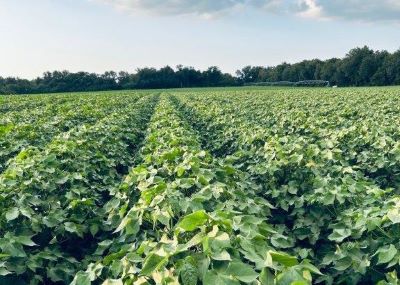 Photo: Wes Briggs
Photo: Wes Briggs
We’re making some of our last Engenia, XtendiMax, and Enlist sprays over-the-top with the state cutoff date (June 30) coming. I’m glad to be moving on past that. Weed management this year has been tough. We had issues with pigweed, goosegrass, and nutgrass, plus issues in getting timely applications on some fields.
The cotton crop looks like cotton should this time of year. The older cotton is moving into peak bloom, and fruit retention looks strong. We do have most of it cleaned up and are moving into the management phase with water, PGRs, and insect control. Stress is always a big factor for us in late July and August. Too much water or lack of water – even heavy fruit loads – can be a stress.
Plant bugs disappeared about a week ago, but we’re now seeing some pockets where they’re as heavy as they’ve been all year. It’s a moving target for us, but we’ve been able to get them cleaned up,
I would guess about 65-70% of our cotton is blooming now. Node above white flower going into first bloom is about 8 or 9 nodes above white flower. That gives us a good idea about crop development. With irrigation, we do have the ability to apply fertilizer through center pivots to fix most of our problems, as long as the calendar days aren’t catching up with us.
Our dryland acres have caught some timely rains, and that cotton looks good. Hopefully, we can get a few more rains on them.
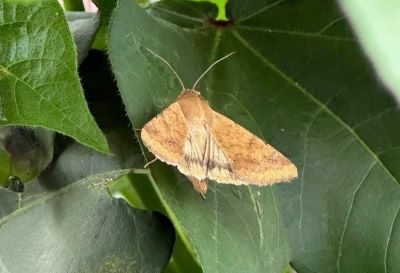 Corn Earworm (Wes Briggs)
Corn Earworm (Wes Briggs)
We’re in a heavy corn earworm flight right now. But pretty much everything around here is 3-gene cotton, so we don’t have a lot of escapes to date. Our main thing is plant bug and stink bug management. And, so far, we don’t have any whiteflies showing up, which is great. That can get expensive in a hurry.
Tucker Miller is a Mississippi-based independent private consultant for cotton, soybeans, corn, peanuts, rice, and vegetables.
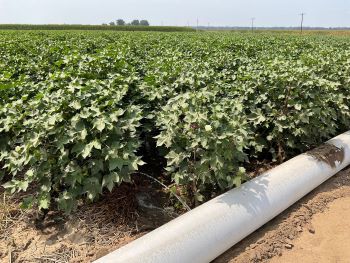 (Photo: Tucker Miller)
(Photo: Tucker Miller)
We are full out irrigating our cotton, mostly with poly pipe down the row with a few pivots still in commission. Our cotton ranges from NAWF 5 to NAWF 7. The cotton is fruited up really well. A rain in the next few days would be worth a lot.
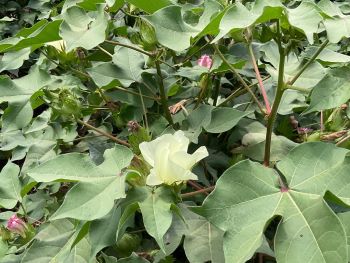 (Tucker Miller)
(Tucker Miller)
Spider mites are popping up everywhere in this hot, dry weather. We finally got the grass and weeds cleaned up on the edges and around well heads, then laid pipe and spread mites everywhere. We are adding miticides to our plant bug sprays where needed. We have been under a bollworm egg lay for two weeks now, but the Bollgard III has held up well in our area.
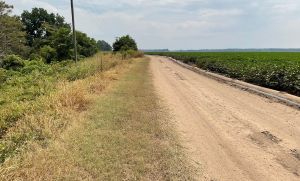 Mite-damaged grass near cotton. (Tucker Miller)
Mite-damaged grass near cotton. (Tucker Miller)
We still have a long way to go with our late planted cotton. It will need to be protected through August. We have seen a little more bacterial blight this year, and we hope it is not a yield limiting factor.
Hope everyone can finish this one out on a good note. Wishing for all blue skies and white cotton.
Mark Nemec is an independent agricultural consultant for cotton, wheat, grain sorghum and corn in the Blacklands and Brazos River Bottom area of Central Texas.
It looks like it’s all over for much of the dryland cotton in Central Texas. The relentless heat has taken what started as a promising crop and burned it up. With temperatures barely going below 80 degrees at night and over 100 during the day – as well as no rainfall for the last 3-4 weeks – the dryland crop shed much of its fruit load. All in all, it will still be a little better than last year yield wise.
Irrigated cotton in the Brazos Bottom is still looking good as long as the water keeps going. Insect pressure has subsided somewhat, but growers still need to keep their eyes open for stinkbugs and spider mites as all wild host plants dry up. Some isolated spots may need some PGRs on the well-watered fields.
From here on out, we just need to fill out all we can and hope for a dry harvest.
Kerry Siders is Texas A&M AgriLife Extension Agent-IPM for Hockley, Cochran, and Lamb Counties.
Cotton ranges from 1/3-grown square to blooming out-the-top on some dryland. Ideally, we would like to be around 6-7 nodes above white flower (NAWF) at this time. This allows us to take full advantage of an “effective bloom period” and have that last bloom set before odds decrease dramatically for full maturity.
The last effective bloom date ranges from the second to the third week in August. As the adage goes – “we make cotton in August” will hold true for this year.
Also, we are hopeful that more moderate temperatures are coming, not the +100-degree temperatures we have had. This will allow cotton to grow at a more normal pace rather than racing towards hard cutout. This will also allow rain and irrigation water to be more efficiently used.
Insect pest issues remain relatively quiet. Fleahoppers have had their time the past several weeks but are mostly behind us now. We are keeping an eye out for Lygus and other plant bugs, as well as cotton aphids. Beneficial insects and spiders have been present in most fields to help if needed.
My priorities for the next few weeks are:
- Keep up with crop water demands. We are at or near peak use in flowering cotton of 0.30” per day.
- Finish all fertilizer applications. Late applications only delay maturity and can encourage cotton aphids.
- Keep a close watch out for cotton aphids, Lygus, stinkbugs, cotton bollworms, and even beet armyworms over the next month.
- Maintain our good square set going into flowering on late cotton and maintain a good boll set with limited damage and losses.
- Do not let cotton vegetative growth get out of hand. Our target of 5 NAWF should be reached around Aug. 5. This allows us to literally bloom out the top on our last effective bloom date of approximately Aug. 20.















